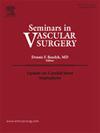用尽透析通道的替代方案。
IF 2.4
3区 医学
Q1 PERIPHERAL VASCULAR DISEASE
引用次数: 0
摘要
血液透析(HD)通路失败是血管外科医生经常遇到的问题。随着终末期肾病治疗的改善和HD患者寿命的延长,传统的上肢HD通道最终衰竭是很常见的。保护和维护这些通道的努力至关重要。然而,当它们失败时,应在目的隧道透析导管之前寻求其他手术通路选择。血液透析可靠的流出性移植物,以及各种配置的下肢动静脉瘘和移植物都可以使用。与传统方案相比,对于大多数替代HD接入方案,缺乏长期通畅、成本和感染或缺血性并发症风险的数据。然而,对血液透析可靠流出体移植物、股静脉转位和下肢移植物的小型研究显示出可接受的安全性和有效性。根据传统通路失败的原因和患者特定的解剖限制,我们建议采用一种系统的方法来创建替代通路,保留目的隧道透析导管作为最后的手段。HD通道失败最常见的原因是静脉流出梗阻。因此,我们围绕回顾性研究的荟萃分析构建了这篇论文,这些研究描述了可以用于中心静脉狭窄或闭塞程度不断升级的非传统通路选择。本文章由计算机程序翻译,如有差异,请以英文原文为准。
Alternatives for exhausted dialysis access
Hemodialysis (HD) access failure is a frequent problem encountered by vascular surgeons. As treatment of end-stage renal disease improves and patients live longer on HD, eventual exhaustion of traditional upper extremity HD access is common. Efforts to preserve and maintain these accesses are essential. However, when they fail, alternative surgical access options should be pursued prior to destination-tunneled dialysis catheters. Hemodialysis Reliable Outflow grafts as well as various configurations of lower extremity arteriovenous fistulae and grafts can be utilized. For most alternative HD access options, there is a paucity of data for long-term patency, cost, and risk of infectious or ischemic complications compared to traditional options. However, smaller studies examining Hemodialysis Reliable Outflow grafts, femoral vein transposition, and lower extremity grafts show acceptable safety and efficacy. Depending on the cause of traditional access failure and patient-specific anatomic constraints, we recommend a systematic approach to alternative access creation, with destination-tunneled dialysis catheters reserved as a last resort. The most common cause of HD access failure is venous outflow obstruction. As such, we have structured this manuscript around a meta-analysis of retrospective studies describing nontraditional access options that can be utilized with escalating degrees of central venous stenosis or occlusion.
求助全文
通过发布文献求助,成功后即可免费获取论文全文。
去求助
来源期刊
CiteScore
3.50
自引率
4.00%
发文量
54
审稿时长
50 days
期刊介绍:
Each issue of Seminars in Vascular Surgery examines the latest thinking on a particular clinical problem and features new diagnostic and operative techniques. The journal allows practitioners to expand their capabilities and to keep pace with the most rapidly evolving areas of surgery.

 求助内容:
求助内容: 应助结果提醒方式:
应助结果提醒方式:


